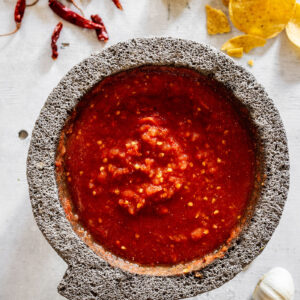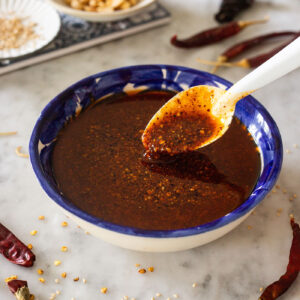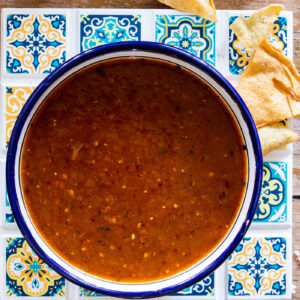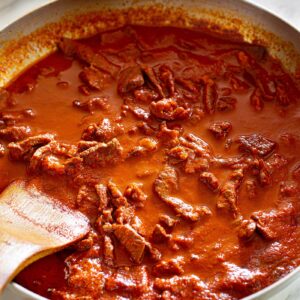Chile de Árbol is a Mexican pepper with just the right amount of heat that will turn any dish special with a smoky and sweet flavor. Want to learn more? Read this article!
If you enjoy cooking and haven’t heard about chile de árbol pepper, you still have a lot to learn. This Mexican pepper is unique and can bring a lot of flavor to your dishes.
Found all year long, there are a lot of tasty recipes to explore and get creative with it. Arbol peppers are an excellent choice if you don’t want to have a dish controlled by the spiciness but still want to feel it while enjoying the combination of other flavors.
Got intrigued? Then, keep reading and learn a bit more about árbol chile!
What Is Chile de Árbol?
Chile de árbol is a small red pepper that usually doesn’t exceed 3 inches long or ½ inch wide. But, don’t be fooled by it! The taste is all concentrated there.
Its name is Spanish and means “tree chili” in English, but it is also known as pico de pájaro (bird’s beak chile) or rat’s tail chile. These names refer to its appearance and slenderness, which can be similar to a tree, beak, or tail.
Originating from Yahualica, Jalisco, some people also call it Yahualica chile peppers. But this name is not so common outside the country or even in that area.

The Spiciness Level
Árbol peppers might not be the spiciest peppers, but they are definitely very hot. Accordingly to the Scoville Scale, which defines heat levels for any type of pepper, this pepper is commonly placed in the 15,000-30000 SHU range.
Therefore, you should be careful when handling and adding them to your dishes.
The heat sensation you feel when tasting chile de árbol is due to a chemical called capsaicin. It is responsible for leaving this burning feeling in your mouth and throat as soon as you chew or swallow it.
So you can better understand its spiciness level, the famous japaleño is at 2500-8000 SHU, while Habanero is over 100000 SHU.

Taste and texture
Árbol chile is not just another regular pepper. It has a nutty flavor with a particular smokiness, making it unique and tasteful for many people. It is a complex condiment with some sweetness and earthy flavor that will linger with the heat for a while.
Although it is a tasteful pepper, you need to be careful to not turn it into a bitter spice. If you accidentally burn it, you will end up with some bitterness that will get in the way of the flavor you were looking for and might ruin your dish.
It is a delicate spice, usually sold as dried. However, the interesting thing about it is that it doesn’t lose its red color after the process, unlike other common peppers that get a maroon color and an old aspect. Inside, you will find a lot of flat and round yellow seeds.
If you want to use them fresh, you will probably have to grow them in your own garden, as you will hardly find them like that at your local market. However, if you do, you can also choose to dry them yourself and guarantee that all the properties are still there.
Nutritional Info
Árbol peppers are great for our immune system, eyes, skin, and health, as they are a great source of vitamin C and A. This nutritional spice is also rich in calcium, which is very important for our bones, keeping them strong and healthy.
Even in such a small condiment, you can still consider it a significant source of iron and fiber. In addition, the capsaicin we talked about earlier is an excellent addition to our immune system and can help lower blood pressure.
This pepper might not be so big in size, but it is huge when you think about its nutritional facts and healthy properties.
Substitutions
As you know, there is a wide variety of peppers that you can easily find. You can opt for Manzano or Pequin chiles if you want the same heat level.
If that is already too much heat for you, maybe try Serrano or Japaleño peppers. Those will still add some hot flavors to your dish, but you won’t have that burning feeling in your throat if you use the right amount.
However, if you are a fan of heat and want a spicy meal, try Habanero or Chiltepin peppers. Be careful while handling these spices, especially not touching your eyes before washing your hands very carefully.
Where To Buy
Outside Mexico, you will find this dried pepper sold at Mexican and Latin American grocery stores, look near the fruits and vegetables, sometimes they are sold in bulks and sometimes packed in small bags of 50, 100, and 200 grams.
If there is a large Mexican community in the city where you live, look also at local supermarkets, they’re usually displayed in the spice or international aisle.
One convenient and easy place to find them is at online stores. The first place of course is to look on Amazon, or research on Google for “Mexican products store”, some stores even offer free shipping.
Note: When you buy arbol chilies, look for those that look pliable (even if they’re dry) and with a bright, red color. This means the peppers are not too old.
Storage
As you will probably buy dried chiles de árbol, the best way to store them is somewhere away from the sunlight and closed inside a bag or jar.
The peppers will last long, almost a year, but their strong and unique flavor can be reduced over time. This is why it is crucial to keep it closed. You will protect the taste and uniqueness of the árbol peppers.

What Can You Use Árbol Peppers For?
There are a lot of recipes to which you can add chiles de árbol if you want to have some heat and a unique flavor. Like many other peppers, it can be transformed into great spicy salsas.
You can use this to complement famous Mexican dishes, like soups and stews, or whichever dish you want to give a particular taste.
Before using the dried peppers, you can do a few steps to make them less spicy and eatable.
Toast it:
- First, cut the end where the tail is attached and remove all the seeds; you won’t need those.
- Next, heat a cast-iron skillet or a comal and toast the peppers for a few seconds to enhance the smoky flavor. Be careful, those peppers toast fast and burn easily.
- You can now use it as a seasoning for your dishes or grind it into chili powder to add heat to the plate.

Hydrating:
Sometimes you’ll need to soften those peppers to make sauces like the one for chicken birria, so you should put them in hot water for about 15 minutes after toasting them.
For this part, wait for the water to boil and turn the stove off before adding the spice árbol chile. This process is essential to rehydrate the pepper and restore its natural appearance, making them also easier to blend with other ingredients.
Chile de árbol recipes
Chile de Árbol is definitely an interesting and particular Mexican pepper that can help you in your cuisine ventures.
And now that you have learned all you needed to know to turn up the heat and flavor on your dishes, let’s see some recipes you might want to try:








If you have any questions for us, please let us know. Meanwhile, check up on the most asked questions about this particular Mexican spice.
FAQ
Are arbol chiles hot?
Yes, to compare it to other chilies, Anaheim peppers have a 500-2,500 level of spiciness at the Scoville Scale (SHU), while chile de arbol is between 15,000 – 30,000.
Is there another name for arbol chiles?
Yes, you can find them also as pico de pájaro (bird’s beak chile), rat’s tail chile, or Yahualica chile peppers.
Is arbol chilies the same as crushed red pepper?
No. Usually, crushed red peppers are a blend of different types of red chilies, most of them with a low spicy profile. Powdered or crushed arbol peppers are not only hotter but also have a different and more delicious flavor.
What do dry arbol chiles taste like?
Those Mexican peppers have a distinctive nutty, slightly grassy flavor with a hit of nuttiness.
How long last those dried peppers?
Nicely stored in jars, away from humidity and sunlight, those peppers can last up to a year.
Can I grow my own chile de arbol peppers?
Yes, you can! I strongly suggest learning as much as you can about growing chile peppers from seeds at home, this amazing guide for growing chiles is one of my favorites, you should really take a look at it.
I hope you enjoyed this article and please don’t forget to rate it and leave a comment below. Remember also that you can share it on your social media and follow this blog on PINTEREST, INSTAGRAM, FACEBOOK, and YOUTUBE.


